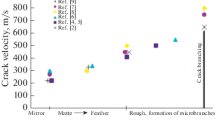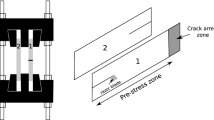Abstract
A slow crack growth was achieved in initially edge-cracked specimens made of a high-molecular weight PMMA by regulating the cross-head speed of loading by a computer-driven testing machine. The strain rate\(\dot \varepsilon \) used during the tests varied between\(\dot \varepsilon \) =1× l0−6 s−1 and 1×10−4 s−1.
It was shown that, in this zone of slow quasi-static loading of brittle polymethylmethacrylate specimens under conditions of plane stress, the crack initiated for a critical value of loading, at some characteristic zone of strain-rate variation at the crack tip.
It was established that for strain rate between\(\dot \varepsilon \)=0.18×10−5 s−1 and\(\dot \varepsilon \)=0.45×10−4 s−1 brittle cracks were propagating always slowly with velocities in the range ofc=3 to 5×10−2 m/s. For values ofv s outside this transition zone fracture was typically brittle with high crack-propagation velocities.
As the strain rate was varying beyond the stable low-velocity region, a two-step crack velocity pattern was operative, where the one step took always low values, and the other step corresponded to crack-propagation velocities significantly higher than these limits, tending to typical brittle-fracture velocities of the material. Oscillations of the velocityc at the transition zones, or, in many cases all over the zone of slow propagation of the crack, indicated the unstable character of crack propagation, influenced by different stress raisers and especially by the opposite longitudinal boundary of the specimen.
Stress intensity factor values during crack propagation, evaluated from the front (cuspoid) and the rear (external) caustic, which remained alwaysk g-dominant, were following similar trends as the variation of the crack propagation velocity.
Similar content being viewed by others
References
Döll, W., A molecular weight dependent fracture transition in polymethylmethacrylate. J. Mater. Sci.10, 935–942 (1975).
Döll, W., G. W. Weidmann, Transition from slow to fast crack propagation in PMMA. J. Mater. Sci.11, 2348–2350 (1976).
Cotterell, B., Velocity effects in fracture propagation, Appl. Mat. Research4, 227–232 (1965).
Johnson, F. A., J. C. Radon, Molecular kinetics and the fracture of PMMA. Engng. Fract. Mech.4, 555–576 (1972).
Rosenfield, A. R., M. F. Kanninen, The fracture Mechanics of glassy polymers. J. Macromol. Sci. (Physics)B7 (4), 609–631 (1973).
Kerkhof, F., Wave Fractographic Investigations of Brittle Fracture Dynamics, Proc. Intern. Conf. Dynamic Crack Propagation, Lehigh University USA July 1972, G. C. Sih Editor, Noordhoff Leyden, pp. 3–29 (1973).
Marshall, G. P., L. E. Culver, J. G. Williams, Crack Growth in PMMA in Air, Plastics and Polymers37, pp. 75–81 (1969).
Theocaris, P. S., Elastic stress intensity factors evaluated by caustics. Mechanics of Fracture-VII 189–252 G. C. Sih Ed., M. Nijhoff, Hague, 1980.
Theocaris, P. S., G. A. Papadopoulos, Elastodynamic forms of caustics for running cracks under constant velocity. Engng. Fract. Mech.13 (4-A), 683–698 (1980).
Williams, J. G., The thermal properties of the plastic zone. Appl. Mat. Res.4, 104–112 (1965).
Williams, J. G., Visco-elastic and thermal effects on crack-growth in PMMA. Int. J. Fract. Mech.8 (4), 393–401 (1972).
Theocaris, P. S., D. Pazis, Some further properties of caustics useful in mechanical applications, Appl. Optics20, 4009–4018 (1981).
Theocaris, P. S., The method of caustics for the study of cracked plates made of viscoelastic materials, Proc. 3d Int. Conf. Fract., München, Germany, Vol. VI, (1973).
Author information
Authors and Affiliations
Rights and permissions
About this article
Cite this article
Theocaris, P.S. Slow-brittle-fracture transition in polymethylmethacrylate. Colloid & Polymer Sci 261, 825–833 (1983). https://doi.org/10.1007/BF01421436
Received:
Accepted:
Issue Date:
DOI: https://doi.org/10.1007/BF01421436




